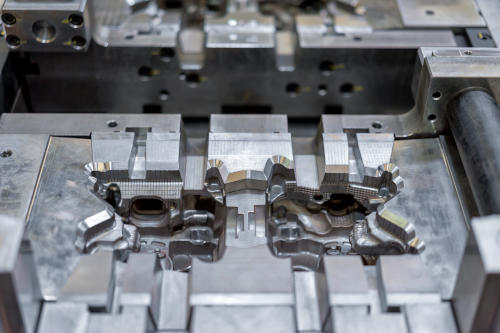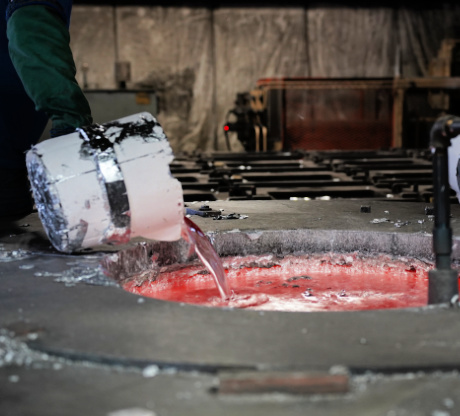Upcoming innovations of aluminum casting technology explained
A Comprehensive Guide to Aluminum Casting: Strategies, Makes Use Of, and Industry Insights
Aluminum casting is an essential process with diverse applications across several markets. This overview checks out various casting methods, including sand, die, and investment casting. Each approach has distinctive advantages, adding to aluminum's track record for corrosion-resistant and light-weight components. Recognizing these techniques is crucial for makers wanting to utilize aluminum's buildings. The landscape is swiftly progressing. The effect of existing trends on future practices warrants further expedition.
Comprehending Aluminum: Residences and Advantages
Aluminum, a functional steel, is extensively acknowledged for its distinct buildings that make it a perfect choice for different applications. It is lightweight yet strong, supplying an outstanding strength-to-weight ratio that is specifically useful in industries such as aerospace and auto. Furthermore, aluminum exhibits extraordinary corrosion resistance because of the formation of a safety oxide layer, which enhances its durability and long life.
The metal is also highly flexible, permitting easy shaping and manufacture, which contributes to its extensive usage in manufacturing. Aluminum is an excellent conductor of power and warm, making it valuable in electric and thermal applications. Its recyclability includes in its charm, promoting sustainability in making procedures. The mix of these properties not only enhances performance but also decreases energy intake throughout its lifecycle, positioning aluminum as a crucial product in modern engineering and layout.
Overview of Aluminum Casting Techniques

Sand Casting Techniques
Among different aluminum casting techniques, sand casting sticks out as one of one of the most extensively made use of approaches as a result of its versatility and cost-effectiveness. This method entails producing a mold and mildew from sand, which can be quickly shaped to form complicated geometries. The procedure starts with packing sand around a pattern, generally made of metal or plastic, to produce a dental caries that specifies the final shape. As soon as the mold is ready, liquified aluminum is poured right into the tooth cavity, permitting it to cool down and strengthen. Afterward, the sand is gotten rid of, exposing the cast component. Sand casting is especially favored for producing huge elements and small production runs, making it a crucial approach in different markets, consisting of vehicle and aerospace. Its versatility to different layouts enhances its charm.
Die Casting Processes
Die casting processes stand for an extremely reliable approach for creating intricate aluminum get rid of excellent dimensional precision and surface area finish. This strategy includes forcing molten aluminum into a mold and mildew under high pressure, guaranteeing that even the most intricate geometries can be accomplished. There are 2 main kinds of die casting: warm chamber and cold chamber. Warm chamber pass away casting appropriates for steels with reduced melting factors, while cool chamber pass away casting is preferred for aluminum because of its greater melting factor. Both methods promote rapid production and can suit high quantities, making them excellent for sectors such as auto and electronics. Effective die casting needs precise temperature control and mindful mold design to ensure and prevent issues high quality.
Sand Casting: A Conventional Approach
Although modern casting strategies have actually emerged, sand casting remains a foundational method in the aluminum sector as a result of its flexibility and cost-effectiveness. This standard method entails producing a mold and mildew from a mixture of sand and a binding agent, enabling the production of complex shapes and dimensions. Sand casting is especially helpful for low to tool manufacturing volumes, as it minimizes configuration costs and time.
The process starts with the development of a pattern, which is after that placed in the sand to develop a tooth cavity. As soon as the mold and mildew is ready, liquified aluminum is poured in, loading the cavity and taking the form of the pattern. After cooling down, the sand is eliminated, exposing the finished actors part.
Sand casting is commonly used for creating vehicle components, machinery components, and imaginative sculptures, highlighting its long-lasting significance in numerous markets of the aluminum market. (Precision aluminum casting)
Die Casting: Accuracy and Performance
Die casting is a procedure that supplies exceptional precision and effectiveness in aluminum manufacturing. This technique is widely utilized throughout numerous sectors as a result of its capability to create complex forms with limited resistances. Nevertheless, it also offers unique challenges that call for ingenious services to assure ideal results.
Process Review and Conveniences
When considering aluminum casting methods, die casting attracts attention for its precision and effectiveness. This process involves compeling liquified aluminum into a mold under high stress, which permits tight tolerances and detailed styles. The fast cooling of the steel assurances fast solidification, causing high-grade get rid of marginal surface blemishes. Furthermore, die casting deals superb repeatability, making it suitable for big manufacturing runs. Making use of multiple-use mold and mildews considerably decreases product waste and manufacturing time, adding to cost-effectiveness. The stamina and longevity of die-cast aluminum elements make them positive for requiring applications. On the whole, pass away casting combines advanced innovation with functional advantages, placing it as a leading option in aluminum casting strategies.
Applications in Different Industries
The adaptability of die casting allows its application across a wide variety of sectors, showcasing its accuracy and performance. In the automotive industry, pass away casting produces elaborate parts such as engine blocks and transmission housings, contributing to weight decrease and improved efficiency. The electronics market benefits from die casting by creating lightweight and resilient housings for various tools, boosting both functionality and aesthetics. In the aerospace field, this strategy supplies high-strength components that stand up to severe conditions while keeping low weight. Furthermore, customer products manufacturers use pass away casting for creating parts that call for complex geometries and limited resistances. Overall, die casting plays an important duty beforehand modern technology and item layout across numerous industries, highlighting its relevance in modern-day production.
Obstacles and Solutions
Many challenges emerge in the die casting procedure that can influence both precision and efficiency. One substantial concern is the event of flaws such as porosity, which can jeopardize the integrity of the final product. Additionally, maintaining precise temperature level control is essential, as variations can bring about inconsistent product buildings. Tool deterioration also existing challenges, typically causing enhanced production expenses and downtime. To reduce these problems, makers make use of advanced simulation software program to predict prospective issues before production starts. Carrying out normal maintenance routines for equipment and devices additionally helps keep efficiency. Spending in high-grade products and utilizing skilled service technicians can enhance general process dependability, guaranteeing that high requirements of accuracy are constantly met.
Investment Casting: Detail and Intricacy
Financial investment casting is often linked with high accuracy and elaborate designs, its real strength lies in the capacity to generate complicated geometries that would certainly be challenging to achieve through various other making processes. This technique utilizes a wax pattern, which is coated with a refractory material to produce a mold and mildew. When the mold is developed, the wax is disappeared, leaving a dental caries that perfectly reproduces the original pattern.

Applications of Aluminum Castings Throughout Industries
Financial investment casting's ability for producing elaborate aluminum parts has made it a useful technique across various our website industries. In the auto market, aluminum castings are utilized for engine blocks, transmission housings, and suspension components, adding to weight reduction and improved fuel efficiency. The aerospace industry read take advantage of aluminum spreadings in airplane structures, generator real estates, and touchdown gear, where strength-to-weight ratio is crucial. Aluminum Foundry. In addition, the electronic devices sector utilizes aluminum castings for warm enclosures and sinks, making certain reliable thermal monitoring and toughness. In the construction industry, aluminum castings are made use of for architectural elements, window frames, and structural elements, supplying corrosion resistance and aesthetic appeal. The aquatic market integrates aluminum castings in watercraft engines and fittings due to their light-weight and resistance to seawater deterioration. Overall, aluminum castings show convenience and capability, making them crucial in varied applications across many fields
Present Patterns and Future Directions in Aluminum Casting
Current improvements in aluminum casting technology are shaping the future of manufacturing across numerous markets. One notable pattern is the boosting fostering of additive manufacturing strategies, which allow for more complicated geometries and lowered product waste. Furthermore, the combination of automation and robotics simplifies manufacturing procedures, boosting efficiency and precision.
Sustainability is likewise a driving pressure, with suppliers focusing on recycling aluminum and minimizing power intake throughout the casting procedure. This change not only minimizes environmental impact yet additionally lowers functional expenses.
Furthermore, improvements in simulation software make it possible for far better design and optimization of casting processes, leading to better items with fewer defects. As sectors continue to embrace these developments, the need for high-performance and light-weight aluminum elements is anticipated to climb, further solidifying aluminum casting's function in the future of manufacturing. On the whole, these fads highlight a commitment to efficiency, sustainability, and technological innovation in the aluminum casting sector.
Regularly Asked Concerns
What Are the Environmental Influences of Aluminum Casting Processes?

How Does Aluminum Casting Contrast to Various Other Materials?
Aluminum casting deals lightweight, corrosion-resistant residential properties, making it beneficial contrasted to heavier metals like steel. Its thermal conductivity and ease of creating additionally improve its charm, while certain plastics give adaptability lacking in traditional aluminum applications.
What Precaution Should Be Taken During Aluminum Casting?
Throughout aluminum casting, necessary security steps include wearing safety gear, ensuring correct ventilation, utilizing fireproof products, preserving tools frequently, and sticking to safety and security protocols to stop crashes and exposure to dangerous fumes and liquified steel.
How Can I Choose the Right Aluminum Alloy for Casting?
Selecting the right aluminum alloy for casting entails assessing mechanical properties, rust resistance, and desired application. Think about variables like temperature resistance and weldability to assure the selected alloy fulfills details efficiency and resilience needs.
What Are the Usual Defects in Aluminum Castings and Their Solutions?
Common defects in aluminum castings include surface, porosity, and shrinkage blemishes. Solutions entail improving mold and mildew style, managing cooling rates, and making sure appropriate alloy selection, together with applying extensive evaluation techniques to determine and correct these issues successfully.
Amongst the most generally used approaches are sand casting and die casting, each offering distinct benefits and applications. Among numerous aluminum casting techniques, sand casting stands out as one of the most widely made use of techniques due to its adaptability and cost-effectiveness. Hot chamber pass away casting is appropriate for steels with low melting factors, while cold chamber pass away casting is favored for aluminum due to its higher melting point. Modern casting strategies have arised, sand casting continues to be Our site a foundational technique in the aluminum sector due to its adaptability and cost-effectiveness. When thinking about aluminum casting techniques, pass away casting stands out for its accuracy and effectiveness.